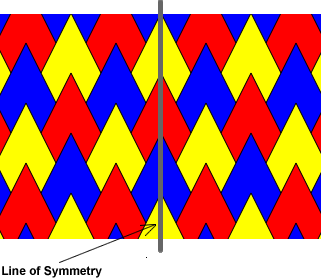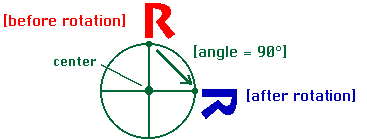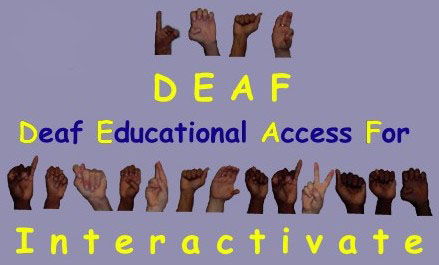
ASL
Student: In the Tessellation activity, the same shape is repeated over and over to make the pattern. Isn't this a type of symmetry?

ASL
Mentor: Yes. There are many symmetries in tessellations. However, you need to be careful that you don't confuse line symmetry with the type of symmetries that we find in the plane of a tessellation.

ASL
Student: I think a figure is symmetric when a line can divide the figure into two congruent halves. A butterfly is an example. If I draw a line down the center of the butterfly's body, each half of the butterfly looks the same, like a mirror reflection.

ASL
Mentor: That's right. What you are describing is called line symmetry, though line symmetry is only one of several types of symmetry. A more precise
definition of line symmetry is that if you draw the line of symmetry, each point on one side of the line has a corresponding point on the opposite side of the line. If you connect these two points, that line is perpendicular to the line of symmetry.


ASL
Mentor: When we are talking about an infinite plane, we refer to the symmetries we find as plane symmetries or geometric transformations.

ASL
Mentor: Your intuition is correct. There are three other types of symmetry in a plane. They all move a pattern in a way that the pattern still matches the original pattern exactly. What other movement can we make to this pattern so that the pattern's appearance doesn't change?

ASL
Student:We could slide the whole pattern sideways.


ASL
Mentor: Correct! This kind of symmetry is called a translation. All translations have a direction and a distance. Can you make a tessellation that does not have translational symmetry?

ASL
Student: Part of the definition of a tessellation is that it is a repeating pattern. So, I think all tessellations have translational symmetry!

ASL
Mentor: Good observation. In what other way can you transform the pattern?

ASL
Student: I could spin the pattern around a point, rotating it. That would leave the pattern unchanged.


ASL
Mentor: This is called rotational symmetry. Rotations always have a center, and an angle of rotation. Can you find one more way to transform the tessellation?

ASL
Student: The only other thing I could do to the pattern would be to reflect it across a mirror line and then translate the pattern. But does that count? I am combining two types of symmetry.

ASL
Mentor: Actually, that is indeed the last type of symmetry and it is called glide reflection. This is the only type of symmetry that involves two steps: a reflection with a translation parallel to the mirror line. Glide reflections are a separate type of transformation because some tessellations have glide reflections, but not reflections or translations. Here is an example:


ASL
Mentor: Now, see if you can make tessellations with different combinations of transformations.



